Development of a Jet Drive for Small
Boats
using a Commercial Water Pump - Part 1
by Steve
Hansen
To Part 2
Background
Having a general like for boats
that are small and slow, a desire to incorporate a jet drive would
seem to be against my general leanings. After all, this mode of
propulsion is usually associated with either high power aluminum
jet boats that are designed to safely navigate the shallow and
rock-strewn rivers of the western USA or those (in my view) obnoxious
mosquitos of the lakes, the PWCs aka jet-skis.
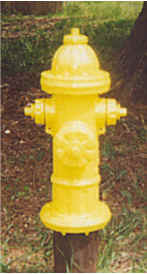 Good specs, but how
Good specs, but how
do I fit it to my boat? |
However, there are many shallow
backwaters for which a low power jet drive might be useful. There
are no props to foul, no lower units to bend and draft is essentially
as little as what the hull is designed for. Admittedly, push poles
or a skulling oar would also serve the purpose well and regular
paddles and oars aren't too bad either. However, they are not
the best solution in areas where there can also be substantial
tidal currents or where you would like to go just a tad faster.
I envision something that can push
a displacement hull to between 5 and 10 mph in the shallow mud
flats of our local coastal estuaries and rivers, is compatible
with salt water, uses a small 4-stroke implement engine and is
not too expensive. Furthermore the main part of the assembly (pump
and engine) should be portable so that it could be used in more
than one boat.
A boat having such a drive would
also have a set of manual propulsors (oars, pole, paddles, etc.)
and possibly an electric motor for fishing or for just being quiet
and stealthy.
On the market today there are at
least two commercial products that use such drives. One is the
Mokai, a rotomolded duck/fishing/pleasure craft that is designed
around an axial jet powered by a Honda 5.5 hp engine. Top speed
is stated to be in the 15 mph range. Details can be found at the
website of Mokai Manufacturing.
The other implementation that I
am aware of is the line of kayaks manufactured by PowerKak.
These are adaptations of standard rotomolded kayaks that have
a small axial drive with a weedwhacker-type 4-stroke gas engine.
There is a reasonably extensive patent literature on small jet
drives and boats using such drives. Several compendia on these
patents can be accessed at https://www.belljar.net/patents.htm.
Selecting a Pump/Motor
Combination
Not being sure how successful a
small jet drive would be I wanted to keep expenses to a minimum.
After looking at the complexities of axial drives including the
possibility of adapting one from a wrecked jet ski, I took the
direction of using a stock centrifugal water pump. One that caught
my eye was a polyester thermoplastic corrosion resistant pump
by Pacer Pumps. The particular model I selected
was their 200 gpm unit that is driven by a 5.5 hp Briggs &
Stratton Intek engine. Inlet and outlet are for 2 inch pipe and
the maximum pressure rating is 52 psig. The pump is designed for
agricultural applications, is quite corrosion resistant, can be
user serviced and is pretty inexpensive. I got mine at Northern
Tool for $299.
Dry weight is less than 40 lbs.
Pacer doesn't have any real specifications on their site and the
manual is devoid of head vs. volume data. I did find some specs
on the Web, although there are inconsistencies. In general it
looks like the pump has a throughput of about 130 gal/min at a
60 ft. head and 110 gpm at 90 ft.
Testing - Round
1
I received the pump on September
4, 2003. I figured I'd make a simple test jig in the backyard
prior to testing in a boat. I mounted the pump on a plank, secured
to two sawhorses. As a source of water I made an inlet of 2" pvc
pipe that dipped into a 35 gal. plastic trash barrel. The exhaust
was also of 2" pvc and included a 0-60 psig pressure gauge and
a threaded fitting to which a variety of simple nozzles could
be attached. The nozzles could either be directed downward, into
the barrel or off to the side. A picture of the assembly is shown
below.
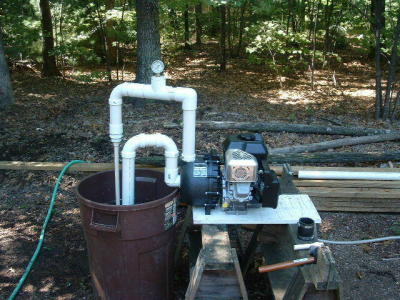
Note that the outlet fitting is
2" pipe thread. As will be noter later, this is important. Testing
with the jet exhausing to the air was limited in duration to just
a few seconds due to the capacity of the barrel. My first air-exhaust
test was with a short length of ¾ inch pvc pipe serving as the
nozzle. Again, the pressure reading at full power was about 40
psig. Here is a picture.
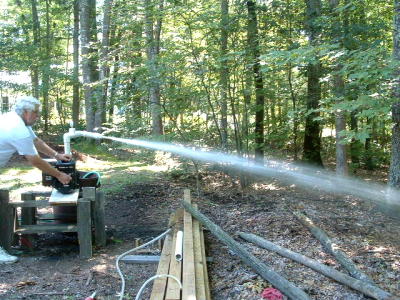
This was almost impressive.
A real quick calculation put the
thrust in the 30 lb. range. Next I tried a nozzle with a 24mm
inside diameter. This nozzle was really just a pvc threaded reducer
so it was nothing in the way of looking like a real nozzle. After
revving up the engine the pressure climbed to about 40 psig and
an extremely imposing blast of water issued from the nozzle. After
a brief moment the whole outlet manifold (remember the 2" pipe
thread fitting) began to spin and an initial attempt to stop it
was futile. The manifold then had a water sprinkler moment until
it unscrewed itself from the pump and took off overhead, landing
about 10 ft away. Soaked and feeling sort of stupid that I didn't
aim the nozzle the other way (so the force would tighten the connection)
I was at least happy that this thing does produce useful thrust.
Another quick calculation had the thrust at around 50 to 60 lbs.
The photo below shows the aftermath.
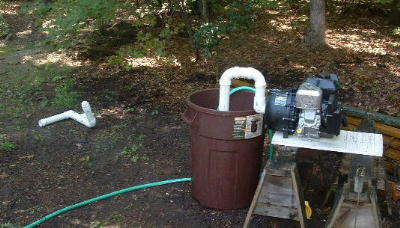
Getting Ready for the Water Trials
The Jet Yuloh
It was now September 7 and we made
arrangements to pay a visit to my sister-in-law Candy's place
on Three Mile Pond, just outside of Augusta, Maine. She has a
12 foot aluminum boat that we figured would be perfect for a water
test of the jet drive. We set the date for the weekend of 20 September
which gave me a couple of weeks to put together the hardware to
install the pump in the boat.
Needing something that could be
just dropped into the boat, I devised a simple over-the-transom
pvc thing that I dubbed the jet yuloh. It was made from 2" pvc
fittings with a somewhat flexible connection to the pump using
2" high pressure water hose, also obtained from Northern Tool.
This stuff is made of reinforced blue vinyl and looks like a cross
between those cheap polytarps and a firehose. Below is a photo
of this assembly.
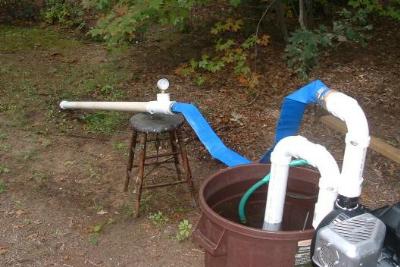
A quick test showed that the jet
yuloh would bore wonderful holes in my wife's bark mulch pile.
I was henceforth banished from backyard testing.
I also got some 2" suction hose from
the same source along with a strainer.
Friday, 19 September and it was off
to Maine!
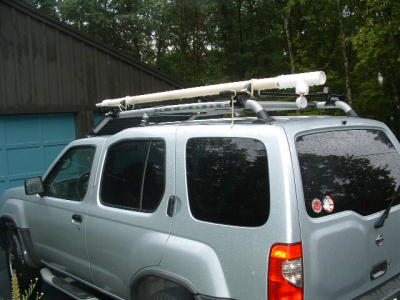
To Part 2
Visit Steve
Hansen's Boat Page

|

